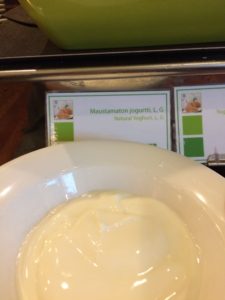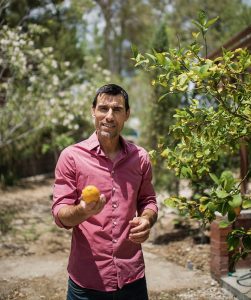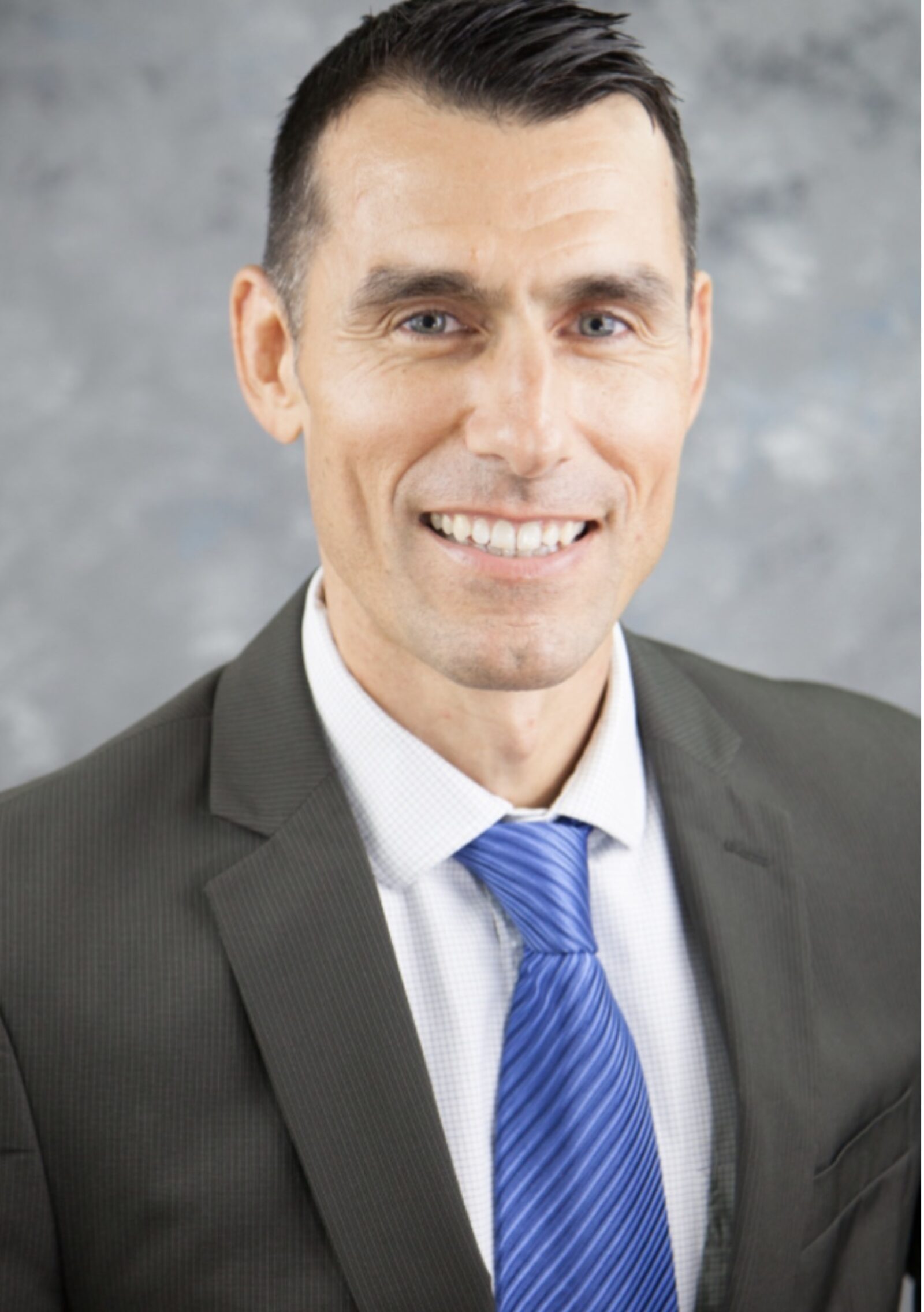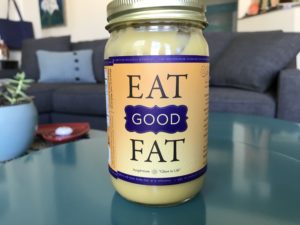ForzaFit™️ blog by Frank Forza:
In this article:
— The RIDDLE OF GHEE BUTTER: Born from a cow BUT IT’S NOT REALLY DAIRY? Huh?? ;
— TALE OF THE TAPE: Grass-Fed Organic Ghee Butter vs. American Butter;
— The POWER OF GHEE BUTTER and a High Fat Diet;
For a long time now, Fat has enjoyed a Filthy Reputation. The Bad Guy at the dinner table. The Demon of the American Diet — a malignancy partly owed to the influence of prominent physiologist Ancel Keys and others who claimed more than a half-century ago that diets high in saturated fat were the primary drivers of skyrocketing cardiovascular disease in America (To be fair, Keys, a Mediterranean Diet cheerleader, lived to be 100 years old).
As I write this, a 16-ounce jar of Organic Ghee Butter sits beside my computer and happens to be packed with Saturated Fat: a whopping 9 grams per tablespoon!
I spread roughly a tablespoon of ghee butter on my morning Organic Buckwheat pancakes (the best and healthiest pancakes to ever pass your lips by the way, the byproduct of 31 years of passion and practice on my part) …. but in any case the ghee butter alone accounted for 120 or so calories …. MEANING 100 PERCENT OF THE GHEE BUTTER IS FAT.
With some exceptions (such as unpasteurized milk from a trusted high-quality farm, or A2 dairy produced in nations like Finland, or occasionally consuming organic yogurts for probiotics) I am not a big fan of Milk and Dairy sold in the U.S. We can argue “’til’ the Cows Come Home” — pun intended — but count me among the Paleo Diet and BulletProof Coffee types and others who consider high-grade grass fed Organic Ghee Butter to be dairy-free, lactose-free, gluten-free and casein-free (supporting story links and partial explanation below).
INTO THE MYSTERY: How is it possible that a product derived from cow’s milk — keeping the butterfat from the milk and throwing mostly everything else away — could be so much healthier for humans than conventional milk? And why am I the latest and greatest to sit here extolling the health virtues of high fat and ghee butter?
(We’ll get to that in a second … but first a wee bit of irony: The particular high-quality brand I use, “Ancient Organics Ghee,” is based in Berkeley, Calif. — home to the very same University of California, Berkeley where Ancel Keys earned his bachelor’s and masters degrees in the 1920s. The Jerry Seinfeld/Larry David philosopher lurking inside me can’t help but stir a sense of wonder that the same city that produced THE POSTER BOY for ‘FAT IS BAD’ propaganda… is also home to some of the best damn 100 % fat Ghee Butter on the globe — and 45 % of all the ghee butter constitutes Saturated Fat)!
Indeed, you probably know at least a few friends who are FALLING IN LOVE with HIGHER FAT these days. Yes, it is a powerful and real movement, my friends. An ever-growing army of scientists, athletes, researchers, etc… are emphatically pounding a different drum these days: FAT is, in fact, FABULOUS.
The “right” fat, at least. Healthy Fats. Which means, as a recent story by Harvard Medical School rightly observed, when it comes to food “Quality Matters.” All olive oils, all coconut oils, all eggs … and so forth … are NOT CREATED EQUAL.

Some yogurt I ate during a trip to Finland, per-capita the world’s most faithful consumers of milk and dairy.
More and more, as I delve deeper down the Rabbit Hole of nutrition for Disease Prevention, Peak Performance and Age Defiance, I am discovering that WHAT YOU ARE EATING < WHO PRODUCED IT? You should value your health enough to constantly ask the question, “Where did this food or drink come from?”
We could sit here all day debating whether humans were meant to drink cow’s milk … but to make it easy … let’s just say that enough documentaries and stories have accurately captured how disgusting and grotesque the U.S. Milk Production Process is, and the cheap and unhealthy chemicals and fake food they typically pump into the cows. It’s generally a rotten game of roulette I don’t want to play with my health: You are what you eat … and if you’re eating a cow pumped with artificial chemicals and cheap GMO FrankenFood … well …. no thank you is the polite way of saying it.

One of my favorite rabbit holes: nutrition. Best estimate: I’ve poured at least several thousand hours of research into this fascinating space, seeking with each passing year to age excellently.
Ghee Butter, based on regularly consuming it for the past four months or so on various dishes, is super benign for my body when consumed in moderation. No stomach issues, no post-meal sugar crash or Food Coma feeling. It’s interesting to note one very telling fact proving that Ghee Butter dramatically differs from American Milk: At room temperature, ghee butter is a solid. Unlike conventional milk, it does NOT require refrigeration. In fact, many ghee butters will last a year or longer with zero refrigeration.
On top of that, Ghee Butter PACKS QUITE THE NUTRITIONAL PUNCH: Omega 3,6 and 9 oils, as well as Vitamin A,D, E and K. And if you really want to go down the Rabbit Hole, realize that some researchers, a fraction but growing in number, claim that the human brain runs better and more efficiently on FAT NOT GLUCOSE (Link to video: Is Ketosis Dangerous? Is Ketosis the Ideal Brain and Body Fuel? https://youtube/Dan8qtgQRi8
If they are right — and I strongly suspect they are — then high-carb, high-protein and high-sugar diets form a Ticking Time Bomb in most Americans and are fueling a tsunami of Disease and Sickness.
Ghee butter is an ancient and unique milk derivative — prepared and extracted differently than we commonly see here in the U.S. (Stay tuned for a future post related to my recent trip to Finland, where the Fins consume the most dairy, milk and cheese per capita in the world yet are a relatively healthy population. I explore that riddle, that dichotomy, and for the sake of mankind and guinea pig science I actually sampled Bree cheese, butter and Finnish yogurt).
A couple of Ghee stories worth reading:
http://www.forbesindia.com/article/think/a-brief-history-of-ghee-in-the-us/41767/1
Some interesting stats regarding MILK and DAIRY consumption, nationally and internationally:
- Americans consumed north of 200 billion pounds of milk and dairy in 2018, according to analysis by Statista.com. While Americans have dramatically reduced their consumption of milk in cereals and as a beverage (by 37-40% according to USDA data), the typical American still consistently and abundantly consumes milk and dairy in alternative forms such as cheese, yogurt, butters, and ice cream.
- On a per capita basis, the people of Finland and Ireland tend to consume the most milk-based products (sources: University of Bristol, University of Helsinki, and the Finnish Dairy Council). However, the nation that overall devours the most milk and dairy (by a landslide margin) is India, followed by the European Union, and then third-place United States.
While the U.S. government annually gives hundreds of millions of dollars to the milk industry (source: The Washington Post), and while the U.S. government has for decades promoted milk and dairy as good sources of Vitamin D, calcium, and protein…
the fact is, from my perspective as a relentless seeker of Optimal Health and Wellness, milk and dairy are completely NON-ESSENTIAL and there are FAR BETTER and cleaner and less toxic food and beverage sources of protein, Vitamin D, and calcium (typically these sources are plant-based, and natural sunlight is a far superior source of immune-boosting Vitamin D).
Based on my philosophy and extensive research, milk and dairy can also be quite antagonistic to the human body because Americans typically consume it on an almost daily-basis (nearly two cups a day) rather than as a every-now-and-then delicacy. Quantity and frequency are key considerations, as applies to many things in life (“the dose makes the poison,” as some pharmacists, doctors, and scientists say). If someone is dealing with advanced atherosclerosis or heart disease, then I think that drinking milk and dairy — generally loaded with added sugars and saturated fat — is a dangerous game of roulette that is particularly best avoided by such high-risk groups.
ONE KEY POINT OF EMPHASIS:
My own nutrition program, which helped me shed 16.5 pounds recently to make 137 pounds and 5.3 % bodyfat in preparation for the IBJJF Masters World Championships last month, is what I call Quasi-Ketogenic — meaning I aim for roughly 60% of my daily caloric intake from healthy fats such as organic coconut oil, olive oil, ghee butter, dark chocolate, nut, avocados, etc…
Going KETO — consuming at least 80% of your calories from fat and entering a state of bodily ketosis, has worked fantastically for some ultra-marathoners, tri-athletes, and those battling chronic seizures. KETO also, preliminarily at least, shows promise for people battling some cancers and diabetes. But I do NOT consider it optimal nor practical for the vast majority of people (a discussion for another day).
Always remember — we are all different and many factors and variables must be weighed when deciding ratios of fat/carbs/protein. While I believe that healthy high fat can work wonderfully for many people and athletes seeking to lose weight and improve athletic performance, not everyone is disciplined enough nor tastebud-fully wired to embrace healthy high fat — and some younger athletes I work with don’t make the shift because they are already producing at a high level despite stuffing themselves with carbs and processed sugars. So again, the key to anything is adapting to people’s needs, goals and personal biology to find a nutrition program that fits their palate, mentality, preferences, and goals.
Experience has taught me, there is no “The Way” only “A Way.” No one-size-fits-all, no ALWAYS, no bulletproof dogma that consists of all pros and zero cons. Even the best nutrition programs MUST be adapted to meet different people’s unique challenges and needs.
ABOUT THE AUTHOR
Frank “The Organic Tank” Forza is the Founder of ForzaFit™️ training systems, a world-class Brazilian Jiu Jitsu black belt, award-winning journalist and widely published writer, Human Performance Coach, and elite Healthy Living strategist.
The University of Maryland-trained philosopher, TEDx speaker, and 3x IBJJF Masters World Champion is a passionate Ambassador of Age Defiance who journeys deep down rabbit holes in search of the best practices that promote human longevity and optimal performance.
To CONTACT FRANK with questions and comments, or regarding corporate speaking events and one-on-one coaching sessions:
Email: frankie@frankieforza.com
Website: www.frankieforza.com
Instagram: frank_forza
Facebook: www.facebook.com/frankieforza
Phone: 702-237-9386


